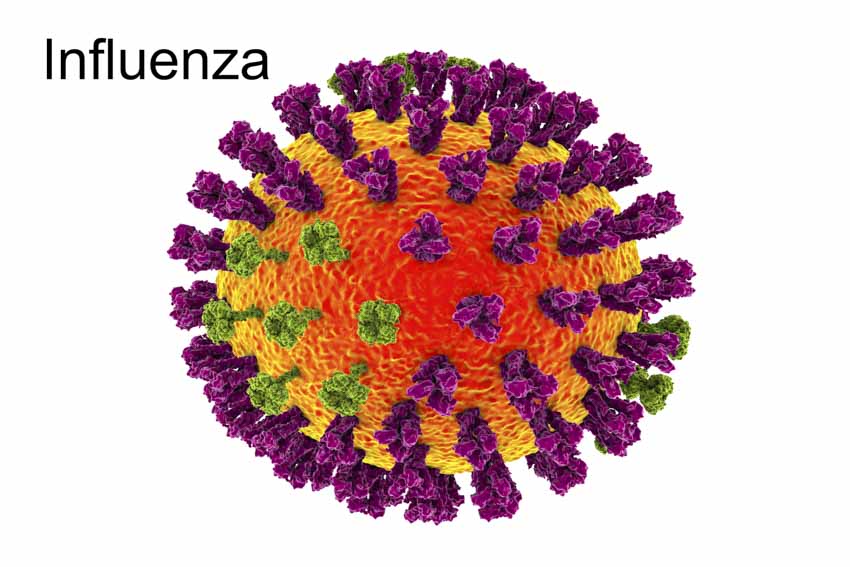Acupuncture is effective for the treatment of influenza. Two independent investigations confirm acupuncture’s efficacy for fighting influenza. One laboratory investigation tested acupuncture as a monotherapy and determined that acupuncture lowers mortality rates, increases serum interferon levels, and improves the phagocytosis of viruses. Another investigation finds acupuncture effective for enhancing the clinical efficaciousness of anti-viral drugs. Let’s start with the integrative investigation and we’ll look at the acupuncture monotherapy next.
Researchers from the Taizhou Municipal Hospital combined acupuncture with standard drug therapy. Patients receiving both oseltamivir and acupuncture in a combined treatment protocol had superior patient outcomes compared with patients receiving only oseltamivir. [1] In an independent laboratory experiment, the researchers proved that acupuncture exerts an antiviral effect by increasing the serum level of interferon (IFN) and improves phagocyte function in rats with influenza virus infections. [2]
The research team of Lang et al. compared a control group receiving only oseltamivir (an antiviral drug, also known by the brand-name Tamiflu) and a treatment group receiving both acupuncture and oseltamivir. The treatment group patients had significantly shorter recovery times for relieving fever, pharyngodynia (pharynx pain), and coughing. The researchers conclude that the addition of acupuncture to an oseltamivir treatment regimen increases the effective rate of oseltamivir for the treatment of influenza. Furthermore, the researchers conclude that acupuncture is both effective and safe; acupuncture did not produce any severe adverse effects.
Results
Following treatment, the average recovery time from fever was 63.80 hours in the drug monotherapy control group and 57.05 hours in the acupuncture plus drug treatment group. On average, acupuncture reduced fevers by 6.75 hours.
The average recovery time from pharyngodynia was 80.35 hours in the control group and 71.25 hours in the treatment group. Acupuncture improved the pharynx pain recovery time by 9.1 hours.
The average recovery time from coughing and other symptoms was 115.20 hours in the drug monotherapy control group and 104.70 hours in the acupuncture plus drug treatment group; acupuncture produced an improvement of 10.5 hours. The recovery time refers to the time it takes to completely relieve symptoms (including body temperature ≤37.4 degrees Celsius) for at least 24 hours from the start of treatment. The results showed that acupuncture significantly increases the total effective rate of oseltamivir and the combined therapy shortens the development course of H1N1 influenza.
Design
Researchers (Lang et al.) used the following study design. A total of 80 patients diagnosed with H1N1 influenza were treated and evaluated They were randomly divided into an acupuncture plus drug treatment group and a drug monotherapy control group, with 40 patients in each group. Inclusion criteria were established and included the following:
- H1N1 influenza diagnosis
- Body temperature ≥38 degrees Celsius
- At least two indicative symptoms (e.g., sore throat, coughing)
The statistical breakdown for each randomized group entering the study was as follows. The control group was comprised of 22 males and 18 females. The average age in the control group was 22.55 years. The average course of disease in the control group was 21.73 hours. The body temperature in the control group was 38.59. The treatment group was comprised of 19 males and 21 females. The average age in the treatment group was 24.05 years. The average course of disease in the treatment group was 20.89 hours. The body temperature in the treatment group was 38.71. There were no significant statistical differences in gender, age, course of disease, and body temperature relevant to patient outcome measures for patients initially admitted to the study.
Treatment Procedure
Both groups were given identical drug therapy. A total of 75 mg of oseltamivir was administered twice daily, for a total of 5 days as one treatment course. Symptomatic treatment (antipyretic analgesics, antitussives, or expectorants) were also given if necessary.
The treatment group received acupuncture treatment. The following primary acupoints were selected bilaterally for the treatment group:
- LI11 (Quchi)
- TB5 (Waiguan)
- LI4 (Hegu)
- LU5 (Chize)
Additional secondary acupoints were added based on symptom presentation:
- High fever: GV14 (Dazhui)
- Severe cough: LU6 (Kongzui)
- Sore throat: LU10 (Yuji), LU11 (Shaoshang)
After insertion, needles were manipulated with the attenuation (xie) technique for 2–3 times during a 10–15 minute needle retention time. For Yuji and Shaoshang (used for sore throat patients), the bleeding technique was applied instead of using the attenuation technique. The acupuncture treatment was administered daily, for a total of 5 days as one treatment course.
The Taizhou Municipal Hospital researchers determined that acupuncture improves outcomes for influenza patients taking oseltamivir. This includes reductions of fevers and symptomatic relief. Overall, the total recovery time improves when acupuncture is added to the drug therapy treatment regimen.
Nanjing University
In another investigation, Nanjing University of Traditional Chinese Medicine (TCM) researchers investigated the effect of acupuncture and moxibustion on rats infected with influenza virus. They found that both acupuncture and moxibustion decrease the mortality rate and increase the average survival time. In addition, they document that both TCM therapies significantly increase the serum level of IFN and improve phagocytosis of viruses.
Interferon (IFN) plays a major role in defective neutrophil recruitment and influenza virus killing. [3] The researchers conclude that both acupuncture and moxibustion are effective for the treatment of influenza. Notably, acupuncture produced superior outcomes over moxibustion therapy.
Three groups were compared. The first group received acupuncture. The second group received moxibustion. The third group was a control. For the acupuncture treatment group, a needle was inserted into one single point (Dazhui, GV14) and was manipulated with the twisting technique with a frequency of 30–50 times per minute. For the moxibustion treatment group, 10–15 mg of moxa cigar cuttings were applied upon the acupoint Guanyuan (CV4). A total of 4 cuttings were used in one treatment session. The above treatments were conducted daily, for 3 consecutive days in total. The control group received no treatment.
The mortality rate of the acupuncture treatment group was 63.5% and was 78.6% for the moxibustion group. The control group mortality rate was 96.4%. In addition, overall survival times improves in the acupuncture and moxibustion groups.
The serum IFN level of the acupuncture treatment group was 5.35 log IU/mL and that of the moxibustion treatment group was 4.22. The serum IFN level of both treatment groups was significantly higher that of the control group 2.63. The phagocytosis rate of virus infected cells for the acupuncture treatment group was 62.67% and was 50.58% for the moxibustion treatment group. Both were significantly higher than that of the control group, which was only 20.34%. Overall, acupuncture lower the mortality rate, increases serum interferon levels, and improves phagocytosis of viruses.
Summary
The aforementioned independent investigations indicate that acupuncture is an important treatment option for the treatment of influenza. Acupuncture improves the serum level of IFN and improves phagocytosis of viruses. Patients are encouraged to contact local licensed acupuncturists to consult about treatment options.
References
[1] Lang BX, Jin LQ, Liu SN, Liu XR. Clinical observation on the effect of acupuncture combined with conventional therapy on influenza H1N1 [J]. Chinese Archives of Traditional Chinese Medicine, 2011, 29(2):411-412.
[2] Chou YF, Cao YM, Wang JL, Yang ZM, Qiu ML. Protective effect of acupuncture on mice infected with influenza virus [J]. China Journal of Traditional Chinese Medicine and Pharmacy, 1990(2):16-18.
[3] Wenjing Li, Bruno Moltedo, Thomas M. Moran. Type I Interferon Induction during Influenza Virus Infection Increases Susceptibility to Secondary Streptococcus pneumoniae Infection by Negative Regulation of T Cells [J]. Journal of Virology, Oct 2012, 86 (22) 12304-12312.






